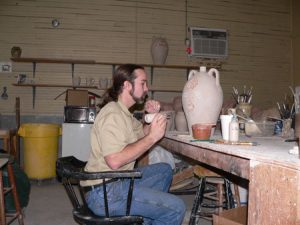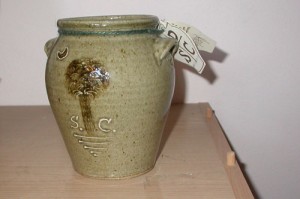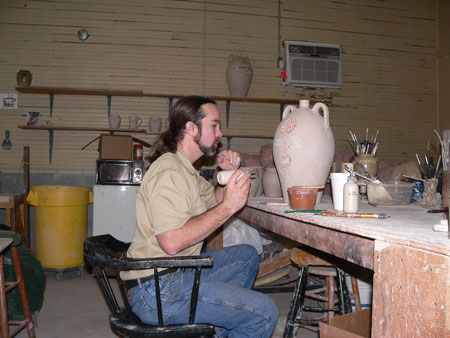
And New Pottery Stash Clues –
By Justin Guy –
When we think of a potter today most people imagine a person seated in front of a rather small machine with a flat disc which is kept reliably turning with the use of
a pedal and electric motor. It is easy to forget that this modern concept is far distant from the first technologies that humans developed to “turn pots.” The comparison between these two extremes is rather like comparing a Cadillac Escalade to its ancient origin of the horse and buggy.
In the beginning of course there was not a potter’s wheel. Potters in those times would simply insert their thumb into a ball of clay and begin to pinch the walls thinner as they turned the vessel in their hand. This vessel upon completion could not have been much larger than a modern coffee mug, and was incapable of cooking the family meal. However, this primordial pot was excellent for gathering embers from last nights fire and traveling comfortably with its owner to the next nights camping spot. Starting the nightly fire before the age of strike-anywhere-matches was made infinitely easier by simply putting dry grass on already hot embers and early pot technology made this a lot easier.
It would not be long, however, before pots were desired for the preparation and storage of food, so technology had to evolve. This simply involved starting the base of a pot on top of a somewhat flattened stone. Coils of clay could be rolled out and continued to be stacked and smoothed one layer at a time. So that the potter could stay in one position while focusing on the coils, the stone under the base would be turned by an assistant or the potter’s feet. This technique is still used in parts of Europe and Africa today.
For many years this was as far as pottery technology would or could go. The next step had to coincide with humans learning how to stay put in one place. It doesn’t take too much imagination to see that a potter’s wheel does not come in a travel size for our nomadic hunter-gatherer ancestors. Even the most enthusiastic prehistoric potter would not relish hauling a 300 lb piece of equipment while in pursuit of migrating herds of mastodons. Humans had to have cities with a stable social structure so that our potter could have the luxury of settling down and setting up shop. So, somewhere around 3500 B.C. in the middle east, our happily “civilized” potter would add a lower fly wheel that could be turned on an axis allowing for greater production and the continued evolvement of both wheel and kiln technology. Coincidentally this also helps to usher in the great age of wine. In fact when archeologists find goblets at a particular layer in their excavations, they can be pretty confident that the civilization they are studying has acquired pottery wheel technology. That is because the stem of a goblet is nearly impossible to make with out the rotating motion of well-engineered potter’s wheel. And so the potter’s wheel would stay very similar in this nature for the next 5000 years until in the 19th and 20th centuries, it would join forces with industry and be attached to steam engines and electric motors.
So a lot of time, energy and engineering has been put into what is essentially a table that will turn smoothly in a particular direction, and all for the purpose of allowing humans to make bigger and better pots. So whether you are a potter or simply someone who likes to drink wine out of a goblet instead of a glass, we can all be happy for the modern potter’s wheel.
Once again I would like to invite everyone to the April Pottery Stash located in Edgefield, South Carolina. If you wish to participate you are looking for a small clay medallion about two inches across that says “Pottery Stash, April 2013.” The first person to follow the clues to their conclusion and return the medallion to The Edgefield Advertiser, will be the proud owner of a humble but genuine piece of Old Edgefield Pottery. This contest is open to anyone of any age and does not require you to do anything dangerous or destructive to find the medallion. The clues are open to multiple interpretations and if the medallion is located inside you may have to access it during normal business hours. Good luck to all who seek to find.
This week’s clue is:
Turkey Season’s here, and there are quite a few around.
This one likes to look at bears, or where a medallion might be found.


